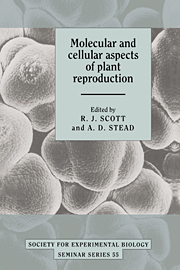Book contents
- Frontmatter
- Contents
- List of Contributors
- Introduction: ‘Where do we go from here?’
- Molecular control of floral organogenesis and plant reproduction in Petunia hybrida
- Control of floral morphogenesis in cauliflower (Brassica oleracea L. var. botrytis): the role of homeotic genes
- Isolation and properties of mutants of Arabidopsis thaliana with reduced sensitivity to short days
- Asexual mutants in Melandrium album (Silene alba): tools in cDNA cloning and analysis of an X/Y chromosome system in plants
- Pollen exine – the sporopollenin enigma and the physics of pattern
- The diversity and regulation of gene expression in the pathway of male gametophyte development
- Characterisation of Arabidopsis thaliana anther-specific gene which shares sequence similarity with β-1,3-glucanases
- Ovule cDNA clones of Petunia hybrida encoding proteins homologous to MAP and shaggy/zeste-white 3 protein kinases
- Towards the elucidation of the mechanisms of pollen tube inhibition during the self-incompatibility response in Papaver rhoeas
- Intracellular movement and pollen physiology: progress and prospects
- Organisation and functions of cell surface molecules on gametes of the brown algae Fucus
- Strategies of flower senescence – a review
- The physiology of petal senescence which is not initiated by ethylene
- Molecular biology of flower senescence in carnation
- Ethylene sensitivity and flower senescence
- Ethylene biosynthetic genes and inter-organ signalling during flower senescence
- Index
Isolation and properties of mutants of Arabidopsis thaliana with reduced sensitivity to short days
Published online by Cambridge University Press: 04 August 2010
- Frontmatter
- Contents
- List of Contributors
- Introduction: ‘Where do we go from here?’
- Molecular control of floral organogenesis and plant reproduction in Petunia hybrida
- Control of floral morphogenesis in cauliflower (Brassica oleracea L. var. botrytis): the role of homeotic genes
- Isolation and properties of mutants of Arabidopsis thaliana with reduced sensitivity to short days
- Asexual mutants in Melandrium album (Silene alba): tools in cDNA cloning and analysis of an X/Y chromosome system in plants
- Pollen exine – the sporopollenin enigma and the physics of pattern
- The diversity and regulation of gene expression in the pathway of male gametophyte development
- Characterisation of Arabidopsis thaliana anther-specific gene which shares sequence similarity with β-1,3-glucanases
- Ovule cDNA clones of Petunia hybrida encoding proteins homologous to MAP and shaggy/zeste-white 3 protein kinases
- Towards the elucidation of the mechanisms of pollen tube inhibition during the self-incompatibility response in Papaver rhoeas
- Intracellular movement and pollen physiology: progress and prospects
- Organisation and functions of cell surface molecules on gametes of the brown algae Fucus
- Strategies of flower senescence – a review
- The physiology of petal senescence which is not initiated by ethylene
- Molecular biology of flower senescence in carnation
- Ethylene sensitivity and flower senescence
- Ethylene biosynthetic genes and inter-organ signalling during flower senescence
- Index
Summary
Introduction
Daylength is the most powerful environment factor in the regulation of the onset of flowering (Vince-Prue, 1975). Changes in photoperiod through the year provide an unambiguous index of seasonal progression. Through the ability to detect and respond to daylength, plants can tailor flowering to seasonal changes in climate, and can also ensure synchrony of flowering to facilitate outbreeding. Plants are classified as short-day plants (SDP), long-day plants (LDP), day neutral plants (DNP) or combinations of these. SDP flower in response to days shorter than a critical daylength, LDP flower in response to days longer than a critical daylength and DNP flower irrespective of daylength. Some plants show a requirement for particular sequences of daylengths or other combinations of the above basic types (Thomas & Vince-Prue, 1984). Photoperiodic requirements may themselves be the only determining factors, but frequently they are overlaid on other developmental or environmental factors, the most important being juvenility and vernalisation (Thomas, 1993).
Photoperiodic mechanisms
Daylength is generally accepted as being perceived by the leaves in both SDP and LDP, rather than in the apex where the transition to flowering occurs. When a permissive daylength is perceived, a semi-stable change in the properties of the leaves occurs. This can be demonstrated by the ability of such leaves to cause flowering when grafted to plants maintained in non-permissive daylengths (for example, Zeevaart, 1969). The change in the leaf is called induction and the molecular basis of the change is unknown.
- Type
- Chapter
- Information
- Molecular and Cellular Aspects of Plant Reproduction , pp. 31 - 38Publisher: Cambridge University PressPrint publication year: 1994
- 12
- Cited by



